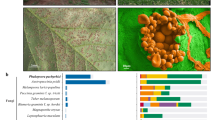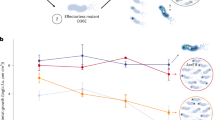Abstract
The frequency of possible “horizontal” gene transfer between a plant and a tightly associated bacterial pathogen was studied in a model system consisting of transgenic Solanum tuberosum, containing a β-lactamase gene linked to a pBR322 origin of replication, and Erwinia chrysanthemi. This experimental system offers optimal conditions for the detection of possible horizontal gene transfer events, even when they occur at very low frequency. Horizontal gene transfer was not detected under conditions mimicking a “natural” infection. The gradual, stepwise alteration of artificial, positive control conditions to idealized natural conditions, however, allowed the characterization of factors that affected gene transfer, and revealed a gradual decrease of the gene transfer frequency from 6.3×10−2 under optimal control conditions to a calculated 2.0×10−17 under idealized natural conditions. These data, in combination with other published studies, argue that horizontal gene transfer is so rare as to be essentially irrelevant to any realistic assessment of the risk involved in release experiments involving transgenic plants.
This is a preview of subscription content, access via your institution
Access options
Subscribe to this journal
Receive 12 print issues and online access
$209.00 per year
only $17.42 per issue
Buy this article
- Purchase on Springer Link
- Instant access to full article PDF
Prices may be subject to local taxes which are calculated during checkout
Similar content being viewed by others
References
Bergmans, H. 1993. Acceptability of die use of antibiotic resistance genes as marker genes in transgenic plants. p. 106–108. In: OECD Report on the Scientific Approaches for the Assessment of Research Trials with Genetically Modified Plants. April 6–7,1992. Jouy-en-Josas.
Rissler, J. and Mellon, M. 1993. Perils amidst the promise. Ecological risks of transgenic crops in a global market. Union of Concerned Scientists, Cambridge, MA.
Kidwell, K. 1993. Lateral transfer in natural populations of eukaryotes. Annu. Rev. Genet. 27: 235–356.
Mazodier, P. and Davis, J. 1991. Gene transfer between distantly related bacteria. Annu. Rev. Genet. 25: 147–171.
Smith, M.W., Feng, D.F. and Doolittle, R.F. 1992. Evolution by acquisition: the case for horizontal gene transfers. Trends Biochem. Sci. 17: 489–493.
Syvanen, M. 1994. Horizontal gene transfer: evidence and possible consequences. Annu. Rev. Genet. 28: 237–261.
Becker, J., Siegert, H., Logemann, J. and Schell, J. 1994. Begleitende Sicherheitsforschung zur Freisetzung gentechnisch veränderter Petunien. p. 563–578. In: Biologische Sicherheit. Forachung Biotechnologie. Band 3. Bundesministerium für Forschung und Technik (Ed.).
Paget, E. and Simonet, P. 1994. On the track of natural transformation in soil. FEMS Microb. Ecol. 15: 109–118.
Smalla, K., Gebhard, F., van Elsas, J.D., Hatzk, A. and Schiemann, J. 1994. Bacterial communities influenced by transgenic plants, p. 157–167. In: Proceedings of the 3rd International Symposium on The Biosafely Results of Field Tests of Genetically Modified Plants and Microorganisms. November 13–16, 1994. Monterey, California.
Broer, I., Dröge-Laser, W., Pretorius-Güth, I.-M. and Pühler, A. 1994. Horizontal gene transfer from transgenic plants to associated soil bacteria. In: Horizontal Gene Transfer—Mechanisms and Implications. Workshop. July 25–27,1994. Bielefeld, Germany.
Hoffmann, T., Golz, C. and Schieder, O. 1994. Foreign DNA sequences are received by a wild-type strain of Aspergiilus niger after co-culture with transgenic higher plants. Current Genet 27: 70–76.
Malnoë, P., Farinelli, L., Collet, G.F. and Reust, W. 1994. Small-scale field tests with transgenic potato, cv. Bintje, to test resistance to primary and secondary infections with potato virus Y. Plant Mol. Biol. 25: 963–975.
Barras, F., van Gijsegem, F. and Chatterjee, A.K. 1994. Extracellular enzymes and pathogenesis of soft-rot Erwinia. Annu. Rev. Phytopathol. 32: 201–234.
Reverchon, S. and Robert-Baudouy, J. 1985. Genetic transformation of the phytopathogenic bacteria, Erwinia chrysanthemi. Biochimie. 67: 253–257.
Cuppels, D. and Kelman, A. 1974. Evaluation of selective media for isolation of soft-rot bacteria from soil and plant tissue. Phytopathology 64: 468–475.
Metting, F.B., Jr. 1993. Structure and physiological ecology of soil microbial communities. p. 3–25. In: Soil Microbial Ecology: Applications in Agricultural and Environmental Management. Metting, F. B., Jr. (Ed.). Dekker, New York.
FAO 1994. FAO yearbook. Production 1993. 47: 89–90.
Calgene 1990. kanr gene: safety and use in the production of genetically engineered plants. Request for advisory opinion. Calgene Inc., CA, USA.
Lichtenstein, C. and Draper, J. 1985. Genetic engineering of plants. p. 67–199. In: DNA Cloning. Vol. II. Glover, D. M. (Ed.). IRL Press, Oxford.
Arumuganathan, K. and Earle, E.D. 1991. Nuclear DNA content of some important plant species. Plant Mol. Biol. Rep. 9: 208–218.
Wilimzig, M. 1985. LiCl-boiling method for plasmid mini-preps. Trends Gen. 158.
Cohen, S.N., Chang, A.C.Y. and Hsu, L. 1972. Nonchromosomal antibiotic resistance in bacteria: Genetic transformation of E. coli by R-factor DNA. Proc. Natl. Acad. Sci. USA 69: 2110–2114.
Author information
Authors and Affiliations
Rights and permissions
About this article
Cite this article
Schlüter, K., Fütterer, J. & Potrykus, I. “Horizontal” Gene Transfer from a Transgenic Potato Line to a Bacterial Pathogen (Erwinia chrysanthemi) Occurs—if at All—at an Extremely Low Frequency. Nat Biotechnol 13, 1094–1098 (1995). https://doi.org/10.1038/nbt1095-1094
Received:
Accepted:
Issue Date:
DOI: https://doi.org/10.1038/nbt1095-1094
This article is cited by
-
ptxD gene in combination with phosphite serves as a highly effective selection system to generate transgenic cotton (Gossypium hirsutum L.)
Plant Molecular Biology (2017)
-
Horizontal gene transfer in plants
Functional & Integrative Genomics (2014)
-
Molecular aspects of gene transfer and foreign DNA acquisition in prokaryotes with regard to safety issues
Applied Microbiology and Biotechnology (2010)
-
Impact of cry1AC-carrying Brassica rapa subsp. pekinensis on leaf bacterial community
The Journal of Microbiology (2009)
-
Investigation of horizontal gene transfer potential from Bt176 maize to phytopathogenic bacterium Erwinia stewartii 1082
World Journal of Microbiology and Biotechnology (2009)



